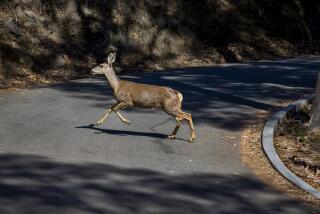State Says Cute Critters Are Mowing Down Trees : Oh Deer! Pennsylvania May Liberalize Hunting
- Share via
COUDERSPORT, Pa. — White-tailed deer graze on tender saplings and fatten up on morsels of red oak, maple, ash and black cherry. Although they are a sight to gladden the heart of a hunter, lumber managers say there are too many deer and they are eating too many trees.
Forestry experts say the deer are mowing down the next generation of valuable hardwoods, causing millions of dollars in damage and eating themselves out of a home.
“Agent Orange (the Vietnam War defoliant) can’t hold a candle to deer,” said David Marquis, a research manager with the U.S. Forest Service who has studied deer damage for 17 years. “They’re four-legged tree killers. The only long-term solution is to bring the deer herd into better balance with its habitat.”
How many deer, then, should populate Penn’s woods?
“There are those who want no deer and those who want one under every bush,” said Ted Godshall of the Pennsylvania Game Commission, which manages the deer population, estimated at about 1 million.
Forests cover 60% of Pennsylvania’s 28.8 million acres. The annual timber crop is valued at $5 billion and 85,000 people in the state work in lumber-related jobs.
The lumber industry is centered on the Allegheny Plateau, 10 million acres of Pennsylvania’s northern tier. It supplies the nation with more than 75% of the quality black cherry logs used to make furniture, according to the USDA.
White ash is the wood of baseball bats, hockey sticks and tool handles; maple is made into flooring, and other woods are used to make rifle stocks and paper.
Pennsylvania also has a million deer hunters, more than any other state, and they take about 300,000 deer each year. Road accidents, stray dogs, farmers and predators kill about 100,000 more. Every year, 400,000 fawns are born, so the herd is stabilized.
Common lumbering practice is to clear-cut a section of trees. Under ideal conditions, 100,000 seedlings per acre grow fast and become the next generation. About 200 of the hardiest trees reach maturity in 80 years. The rest are lost to natural selection, disease and storms.
Then there are the appetites of deer.
A 1975 USDA study found that deer, each eating an average of five pounds of vegetation daily, could cut in half the productive forest land in Pennsylvania.
On the Allegheny Plateau, annual deer damage is estimated at $13.40 an acre in the 80-year growth cycle of hardwoods, according to the USDA. That adds up to a $10-billion loss.
“Overbrowsing by deer is the most serious problem we face in the forest industry,” said Ron Brenneman, wildlife biologist for the International Paper Co. “None of us is saying we should eliminate all the deer. There is a balance that can be struck.”
To outgrow the reach of deer a tree must attain a height of 6 feet, which takes about five years. Foresters are searching for ways to produce so many seedlings that deer cannot eat them all before they are out of reach.
One approach, called a shelter cut, allows new shoots to take hold before an area is clear-cut. Another way is fertilization to speed new growth, but that costs $100 to $140 per acre.
Some lumber companies fence the deer out. International Paper, the largest landowner in the state, with 165,000 acres, has 4,000 acres surrounded by electric fences at a cost of $40 an acre.
Inside the fenced plots, new trees grow too thickly to be walked through. Outside, where deer feed freely, some areas look like meadows.
“Fencing isn’t the solution to the deer problem. This is a Band-Aid. It’s too expensive for most companies,” Brenneman said.
Managing a forest is like farming, except that the growing season takes decades instead of months.
“It’s like trying to keep a cornfield around or keep it from getting blown down by the wind for 80 years to 100 years,” said Bob Bauer, a forester with the state Game Commission.
Foresters would like to see the deer herd reduced by a third, and the Game Commission agrees that some areas are overpopulated.
For example, the goal in Forest County is to have 17 deer per square mile make it through the winter. The number this year was 29 per square mile, and it was 35 in 1985-86.
“We know what damage deer can do to the forest. We are carrying more deer than there should be in some areas,” Godshall said. “We don’t go out and slaughter deer. We try to reduce the number gradually, like 5% a year.”
For the first time, the state will experiment with bonus deer kills this year. The limit has been one deer per hunter each year. Pennsylvania’s two-week buck season opens Nov. 30.
More to Read
Sign up for Essential California
The most important California stories and recommendations in your inbox every morning.
You may occasionally receive promotional content from the Los Angeles Times.










